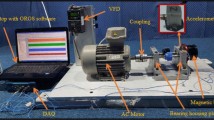Abstract
Gearbox is a significant part for the transmission of vehicles and various mechanical devices and is being utilized broadly in the industries despite of its failure prone nature. Therefore, the need arises for diagnosing the faults present in a gearbox and to rectify the faulty gear. In this paper, deep learning method is utilized for the diagnosis of faulty gears and employs the modified AlexNet for the classification of various gear signals. The hidden units present in the bidirectional LSTM (long short term memory) layer of the AlexNet is selected by proposing an improved grasshopper optimization algorithm (IGOA). After the process of classification, performance evaluation is carried out for various performance measures. It is found that proposed method achieves accuracy of 2.4 %, specificity of −0.3 %, sensitivity of 1.01 %, recall of 0.97 %, precision of 0.59 %. Based on the results obtained it is found that proposed algorithm is more efficient when compared to existing algorithm.
Similar content being viewed by others
References
R. V. Petrescu et al., Gears-part I, American Journal of Engineering and Applied Sciences, 10 (2017) 457–472.
A. Fuentes, R. Ruiz-Orzaez and I. Gonzalez-Perez, Computerized design, simulation of meshing, and finite element analysis of two types of geometry of curvilinear cylindrical gears, Computer Methods in Applied Mechanics and Engineering, 272 (2014) 321–339.
X. Liang, M. J. Zuo and Z. Feng, Dynamic modeling of gearbox faults: a review, Mechanical Systems and Signal Processing, 98 (2018) 852–876.
K. Gupta, Modern manufacturing of miniature gears, Solid State Phenomena (2019) 35–39.
M. Cerrada, R.-V. Sánchez, F. Pacheco, D. Cabrera, G. Zurita and C. Li, Hierarchical feature selection based on relative dependency for gear fault diagnosis, Applied Intelligence, 44 (2016) 687–703.
L. Jing, M. Zhao, P. Li and X. Xu, A convolutional neural network based feature learning and fault diagnosis method for the condition monitoring of gearbox, Measurement, 111 (2017) 1–10.
F. Jia, Y. Lei, L. Guo, J. Lin and S. Xing, A neural network constructed by deep learning technique and its application to intelligent fault diagnosis of machines, Neurocomputing, 272 (2018) 619–628.
A. Stetco et al., Machine learning methods for wind turbine condition monitoring: a review, Renewable Energy (2018).
J. Ding, L. Zhao and D. Huang, On fault diagnosis of gear box based on de-trending multifractal, 2018 IEEE 7th Data Driven Control and Learning Systems Conference (DDCLS) (2018) 830–835.
S. Natarajan, Condition monitoring of bevel gear box using Morlet wavelet coefficients and naïve Bayes classifier, International Journal of Systems, Control and Communications, 10 (2019) 18–31.
M. F. Isham, M. S. Leong, L. Hee and Z. Ahmad, Iterative variational mode decomposition and extreme learning machine for gearbox diagnosis based on vibration signals, Journal of Mechanical Engineering and Sciences, 13 (2019) 4477–4492.
P. Manda, S. Singh and A. Singh, Failure analysis of cooler fan drive gear system of helicopter, Materials Today: Proceedings, 5 (2018) 5254–5261.
C. Li, R.-V. Sanchez, G. Zurita, M. Cerrada, D. Cabrera and R. E. Vásquez, Gearbox fault diagnosis based on deep random forest fusion of acoustic and vibratory signals, Mechanical Systems and Signal Processing, 76 (2016) 283–293.
Y. Qu, M. He, J. Deutsch and D. He, Detection of pitting in gears using a deep sparse autoencoder, Applied Sciences, 7 (2017) 515.
L. Jing, T. Wang, M. Zhao and P. Wang, An adaptive multisensor data fusion method based on deep convolutional neural networks for fault diagnosis of planetary gearbox, Sensors, 17 (2017) 414.
S. Saremi, S. Mirjalili and A. Lewis, Grasshopper optimisation algorithm: theory and application, Advances in Engineering Software, 105 (2017) 30–47.
MathWorks®, Vibration Analysis of Rotating Machinery, https://in.mathworks.com/help/signal/examples/vibration-analysis-of-rotating-machinery.html.
Author information
Authors and Affiliations
Corresponding author
Additional information
Rohit Ghulanavar is studying Doctor of Philosophy in Mechanical Engineering Department of Koneru Lakshmaiah Education Foundation (KLEF) Green Fields, Vaddeswaram, Andhra Pradesh, INDIA, and also working as Assistant Professor in Department of Mechanical Engineering at KIT’s College of Engineering (Autonomous), Kolhapur. He has completed his M.E. in Machine Design from Dr. J. J. Magdum College of Engineering, Jaysingpur Maharashtra, INDIA having seven years of teaching experience in undergraduate engineering education. He is a life time member of Tribology Society of India (TSI) and IAENG, member of the Institutions of Engineers (India). He has published 8 papers in national and international journals and one book in Lambert Academic Publication.
Rights and permissions
About this article
Cite this article
Ghulanavar, R., Dama, K.K. & Jagadeesh, A. Diagnosis of faulty gears by modified AlexNet and improved grasshopper optimization algorithm (IGOA). J Mech Sci Technol 34, 4173–4182 (2020). https://doi.org/10.1007/s12206-020-0909-6
Received:
Revised:
Accepted:
Published:
Issue Date:
DOI: https://doi.org/10.1007/s12206-020-0909-6




